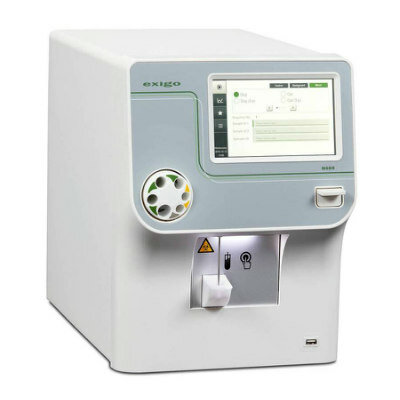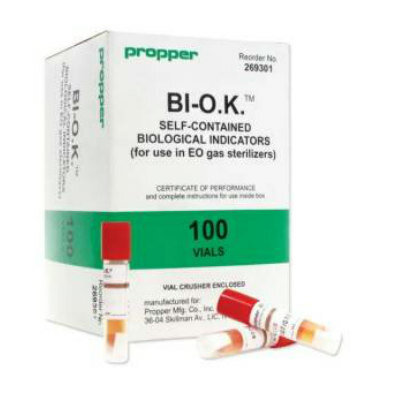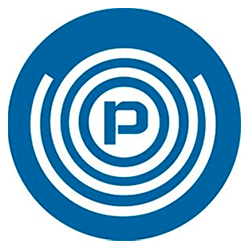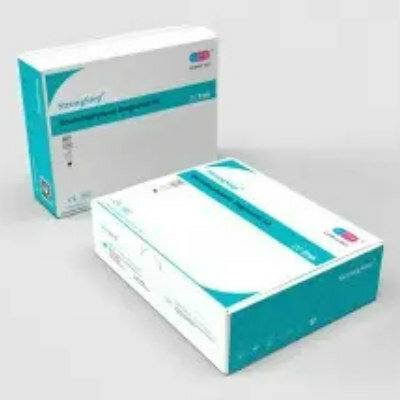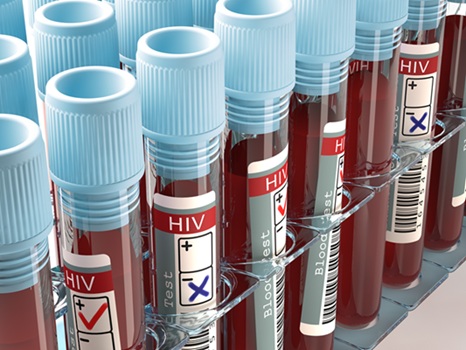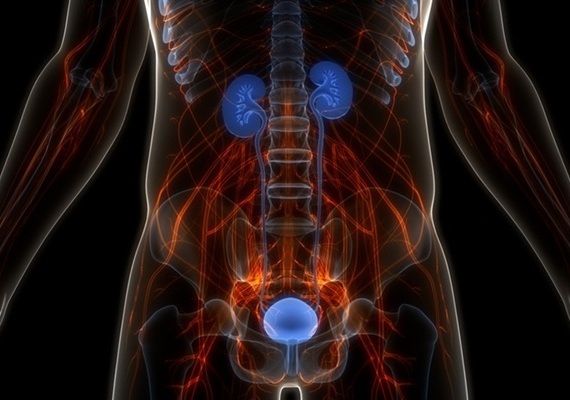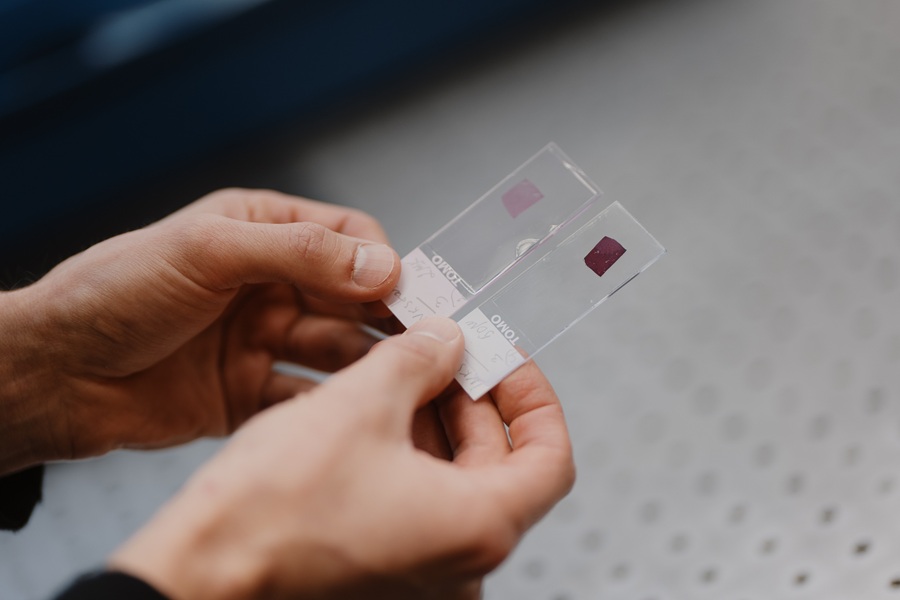Ascitic Fluid Lactoferrin Investigated in Liver Cirrhosis Patients
|
By LabMedica International staff writers Posted on 03 Nov 2016 |
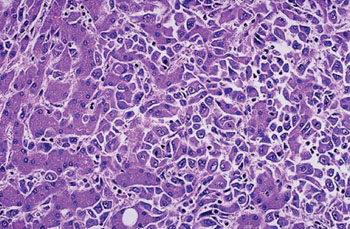
Image: A histopathology image of hepatocellular carcinoma: the malignant cells seen mostly on the right are well differentiated and interdigitate with normal, larger hepatocytes seen mostly at the left (Photo courtesy of SPL).
Although elevated levels of lactoferrin provide a biomarker for inflammatory bowel diseases and colorectal cancer, the clinical significance of these elevated levels in ascitic fluid of patients with ascites caused by liver cirrhosis is limited.
The usefulness of ascitic fluid lactoferrin levels for the diagnosis of spontaneous bacterial peritonitis (SBP) in patients with cirrhosis has been investigated and the association between lactoferrin levels and the development of hepatocellular carcinoma (HCC) has been evaluated.
Doctors at the Gyeongsang National University Hospital (Jinju City, South Korea) consecutively enrolled 102 patients with ascites caused by cirrhosis were from December 2008 to December 2011. Liver cirrhosis was defined by the presence of portal hypertension manifested as splenomegaly, varices, ascites, or hepatic encephalopathy, with compatible findings on diagnostic imaging, in combination with thrombocytopenia of less than 100,000/μL). The diagnosis of SBP was based on a polymorphonuclear cells (PMN) count ≥250 cells/mm3 in ascitic fluid, with or without a positive ascitic fluid or blood culture.
Laboratory tests were performed for anti-hepatitis C virus (HCV), hepatitis B virus surface antigen (HBsAg), anti-hepatitis B virus surface antibody (anti-HBs), white blood cell (WBC) count, hemoglobin level, platelet count, prothrombin time- international normalized ratio (PT-INR), total bilirubin, aspartate aminotransferase (AST), alanine aminotransferase (ALT), gamma glutamyl transpeptidase, serum albumin, creatinine, CRP, and ascitic fluid analysis, including WBC count, PMN count, and albumin levels.
The lactoferrin level in ascitic fluid was quantified using a human lactoferrin enzyme-linked immunosorbent assay kit (Bethyl Laboratories, Inc., Tokyo, Japan). This kit, designed as a sandwich ELISA, captures human lactoferrin present in samples by anti-lactoferrin antibody that has been pre-adsorbed on the surface of polystyrene microtiter wells.
The scientists found that the median ascitic fluid lactoferrin levels were significantly higher in patients with SBP than in those without SBP (112.7 ng/mL versus 0.6 ng/mL). The area under the receiver operator characteristic curve for the diagnosis of SBP was 0.898 with a sensitivity and specificity for a cut-off level of 51.4 ng/mL of 95.8 % and 74.4 %, respectively. Moreover, the incidence of HCC in the 78 patients without SBP was significantly higher in patients with high ascitic fluid lactoferrin levels (≥35 ng/mL) than in those with low ascitic fluid lactoferrin level (<35 ng/mL).
The authors concluded that ascitic fluid lactoferrin level can be a useful diagnostic tool to identify SBP in patients with ascites caused by cirrhosis and elevated ascitic fluid lactoferrin level in patients without SBP may be indicative of a developing hepatocellular carcinoma. The study was published on October 13, 2016, in the journal BMC Gastroenterology.
Related Links:
Gyeongsang National University Hospital
Bethyl Laboratories
The usefulness of ascitic fluid lactoferrin levels for the diagnosis of spontaneous bacterial peritonitis (SBP) in patients with cirrhosis has been investigated and the association between lactoferrin levels and the development of hepatocellular carcinoma (HCC) has been evaluated.
Doctors at the Gyeongsang National University Hospital (Jinju City, South Korea) consecutively enrolled 102 patients with ascites caused by cirrhosis were from December 2008 to December 2011. Liver cirrhosis was defined by the presence of portal hypertension manifested as splenomegaly, varices, ascites, or hepatic encephalopathy, with compatible findings on diagnostic imaging, in combination with thrombocytopenia of less than 100,000/μL). The diagnosis of SBP was based on a polymorphonuclear cells (PMN) count ≥250 cells/mm3 in ascitic fluid, with or without a positive ascitic fluid or blood culture.
Laboratory tests were performed for anti-hepatitis C virus (HCV), hepatitis B virus surface antigen (HBsAg), anti-hepatitis B virus surface antibody (anti-HBs), white blood cell (WBC) count, hemoglobin level, platelet count, prothrombin time- international normalized ratio (PT-INR), total bilirubin, aspartate aminotransferase (AST), alanine aminotransferase (ALT), gamma glutamyl transpeptidase, serum albumin, creatinine, CRP, and ascitic fluid analysis, including WBC count, PMN count, and albumin levels.
The lactoferrin level in ascitic fluid was quantified using a human lactoferrin enzyme-linked immunosorbent assay kit (Bethyl Laboratories, Inc., Tokyo, Japan). This kit, designed as a sandwich ELISA, captures human lactoferrin present in samples by anti-lactoferrin antibody that has been pre-adsorbed on the surface of polystyrene microtiter wells.
The scientists found that the median ascitic fluid lactoferrin levels were significantly higher in patients with SBP than in those without SBP (112.7 ng/mL versus 0.6 ng/mL). The area under the receiver operator characteristic curve for the diagnosis of SBP was 0.898 with a sensitivity and specificity for a cut-off level of 51.4 ng/mL of 95.8 % and 74.4 %, respectively. Moreover, the incidence of HCC in the 78 patients without SBP was significantly higher in patients with high ascitic fluid lactoferrin levels (≥35 ng/mL) than in those with low ascitic fluid lactoferrin level (<35 ng/mL).
The authors concluded that ascitic fluid lactoferrin level can be a useful diagnostic tool to identify SBP in patients with ascites caused by cirrhosis and elevated ascitic fluid lactoferrin level in patients without SBP may be indicative of a developing hepatocellular carcinoma. The study was published on October 13, 2016, in the journal BMC Gastroenterology.
Related Links:
Gyeongsang National University Hospital
Bethyl Laboratories
Latest Clinical Chem. News
- Carbon Nanotubes Help Build Highly Accurate Sensors for Continuous Health Monitoring
- Paper-Based Device Boosts HIV Test Accuracy from Dried Blood Samples
- AI-Powered Raman Spectroscopy Method Enables Rapid Drug Detection in Blood
- Novel LC-MS/MS Assay Detects Low Creatinine in Sweat and Saliva
- Biosensing Technology Breakthrough Paves Way for New Methods of Early Disease Detection
- New Saliva Test Rapidly Identifies Paracetamol Overdose
- POC Saliva Testing Device Predicts Heart Failure in 15 Minutes

- Screening Tool Detects Multiple Health Conditions from Single Blood Drop
- Integrated Chemistry and Immunoassay Analyzer with Extensive Assay Menu Offers Flexibility, Scalability and Data Commutability
- Rapid Drug Test to Improve Treatment for Patients Presenting to Hospital
- AI Model Detects Cancer at Lightning Speed through Sugar Analyses
- First-Ever Blood-Powered Chip Offers Real-Time Health Monitoring
- New ADLM Guidance Provides Expert Recommendations on Clinical Testing For Respiratory Viral Infections
- 3D Printed Point-Of-Care Mass Spectrometer Outperforms State-Of-The-Art Models
- POC Biomedical Test Spins Water Droplet Using Sound Waves for Cancer Detection
- Highly Reliable Cell-Based Assay Enables Accurate Diagnosis of Endocrine Diseases
Channels
Molecular Diagnostics
view channel
RNA-Based Blood Test Detects Preeclampsia Risk Months Before Symptoms
Preeclampsia remains a major cause of maternal morbidity and mortality, as well as preterm births. Despite current guidelines that aim to identify pregnant women at increased risk of preeclampsia using... Read more
First Of Its Kind Test Uses microRNAs to Predict Toxicity from Cancer Therapy
Many men with early-stage prostate cancer receive stereotactic body radiotherapy (SBRT), a highly precise form of radiation treatment that is completed in just five sessions. Compared to traditional radiation,... Read moreNovel Cell-Based Assay Provides Sensitive and Specific Autoantibody Detection in Demyelination
Anti-myelin-associated glycoprotein (MAG) antibodies serve as markers for an autoimmune demyelinating disorder that affects the peripheral nervous system, leading to sensory impairment. Anti-MAG-IgM antibodies... Read moreHematology
view channel
New Scoring System Predicts Risk of Developing Cancer from Common Blood Disorder
Clonal cytopenia of undetermined significance (CCUS) is a blood disorder commonly found in older adults, characterized by mutations in blood cells and a low blood count, but without any obvious cause or... Read more
Non-Invasive Prenatal Test for Fetal RhD Status Demonstrates 100% Accuracy
In the United States, approximately 15% of pregnant individuals are RhD-negative. However, in about 40% of these cases, the fetus is also RhD-negative, making the administration of RhoGAM unnecessary.... Read moreImmunology
view channel
Stem Cell Test Predicts Treatment Outcome for Patients with Platinum-Resistant Ovarian Cancer
Epithelial ovarian cancer frequently responds to chemotherapy initially, but eventually, the tumor develops resistance to the therapy, leading to regrowth. This resistance is partially due to the activation... Read more
Machine Learning-Enabled Blood Test Predicts Immunotherapy Response in Lymphoma Patients
Chimeric antigen receptor (CAR) T-cell therapy has emerged as one of the most promising recent developments in the treatment of blood cancers. However, over half of non-Hodgkin lymphoma (NHL) patients... Read moreMicrobiology
view channel
Handheld Device Deliver Low-Cost TB Results in Less Than One Hour
Tuberculosis (TB) remains the deadliest infectious disease globally, affecting an estimated 10 million people annually. In 2021, about 4.2 million TB cases went undiagnosed or unreported, mainly due to... Read more
New AI-Based Method Improves Diagnosis of Drug-Resistant Infections
Drug-resistant infections, particularly those caused by deadly bacteria like tuberculosis and staphylococcus, are rapidly emerging as a global health emergency. These infections are more difficult to treat,... Read more
Breakthrough Diagnostic Technology Identifies Bacterial Infections with Almost 100% Accuracy within Three Hours
Rapid and precise identification of pathogenic microbes in patient samples is essential for the effective treatment of acute infectious diseases, such as sepsis. The fluorescence in situ hybridization... Read morePathology
view channel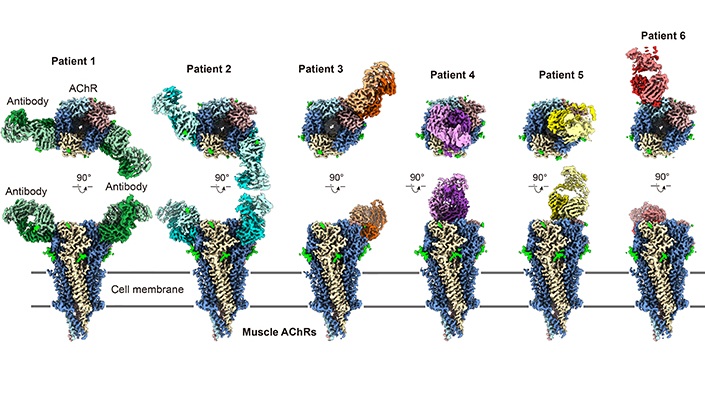
Advanced Imaging Reveals Mechanisms Causing Autoimmune Disease
Myasthenia gravis, an autoimmune disease, leads to muscle weakness that can affect a range of muscles, including those needed for basic actions like blinking, smiling, or moving. Researchers have long... Read more
AI Model Effectively Predicts Patient Outcomes in Common Lung Cancer Type
Lung adenocarcinoma, the most common form of non-small cell lung cancer (NSCLC), typically adopts one of six distinct growth patterns, often combining multiple patterns within a single tumor.... Read moreTechnology
view channel
Pain-On-A-Chip Microfluidic Device Determines Types of Chronic Pain from Blood Samples
Chronic pain is a widespread condition that remains difficult to manage, and existing clinical methods for its treatment rely largely on self-reporting, which can be subjective and especially problematic... Read more
Innovative, Label-Free Ratiometric Fluorosensor Enables More Sensitive Viral RNA Detection
Viruses present a major global health risk, as demonstrated by recent pandemics, making early detection and identification essential for preventing new outbreaks. While traditional detection methods are... Read moreIndustry
view channel
Cepheid and Oxford Nanopore Technologies Partner on Advancing Automated Sequencing-Based Solutions
Cepheid (Sunnyvale, CA, USA), a leading molecular diagnostics company, and Oxford Nanopore Technologies (Oxford, UK), the company behind a new generation of sequencing-based molecular analysis technologies,... Read more
Grifols and Tecan’s IBL Collaborate on Advanced Biomarker Panels
Grifols (Barcelona, Spain), one of the world’s leading producers of plasma-derived medicines and innovative diagnostic solutions, is expanding its offer in clinical diagnostics through a strategic partnership... Read more




